The Guild of Merchant Explorers
- Designers: Matthew Dunstan and Brett J. Gilbert
- Publisher: AEG
- Players: 1-4
- Age: 14+
- Time: 45 minutes
- Played with review copy provided by publisher
As part of our buildup to the announcement of the Spiel des Jahres and Kennerspiel des Jahres this weekend, we are looking at the 3 nominees for each award again.
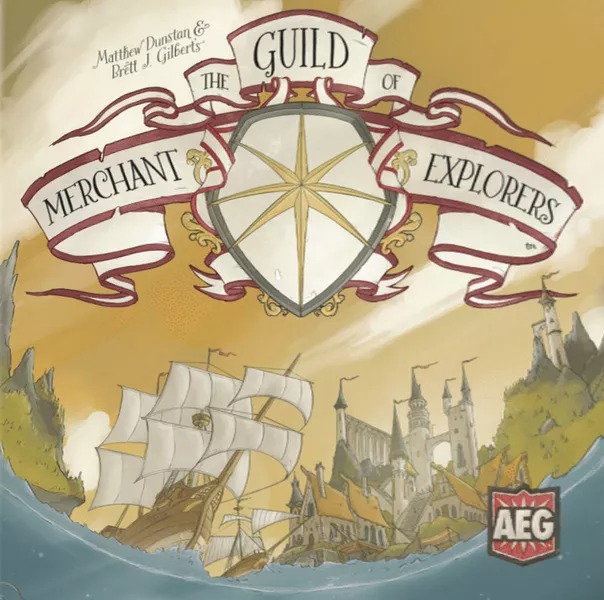
The backstory: “The Queen has sent out a call to the Guild of Merchant Explorers, asking brave adventurers to voyage to all corners of the kingdom of Tigome. While the kingdom is flourishing, its maps have not been updated in some time and its great cities have lost touch with one another. WIth your team of explorers, you will journey over rough seas, towering mountains, vast deserts and lush grasslands to establish trade routes between cities and discover new villages that have emerged. The player with the most coins at the end of the game wins.” (Yes, that last sentence doesn’t make sense in the lore of the story, but that’s what is written in the rules…)
In The Guild of Merchant Explorers, each player starts with one city on their personal map board. The game comes with 4 different maps, and there are already at least 2 more maps in the micro expansion that was released at the same time as the base game. Make sure that all players are using the same map!
The maps all have a capital city on them; this is where all adventuring starts from. There are regions of varying sizes in the four different terrains (grassland, desert, sea, mountain). Most of the spaces are blank. There are some coin spaces where you earn the money shown; ruin spaces where you get Treasure cards, City spaces that score when you connect them, and discovery spaces which score per the chart at the bottom of the map board.
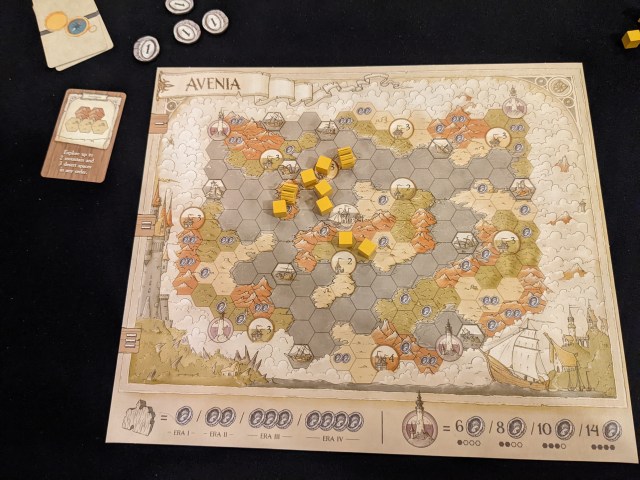
Find the goal cards which match the map you are using, and randomly choose three of them for this game; place them face up underneath the board. Each player gets all of the villages and explorer cubes in their color as well. The main board is placed on the table, and the Exploration Deck, the Investigation Deck and the Treasure Deck are prepared nearby.
The game is played over 4 eras, each with a number of turns equal to the number of cards in the exploration deck. On any given turn, the top card of the exploration deck is revealed, and based on the card shown, each player places on their board cubes that are connected to their starting city or pieces in their color (other cubes or villages). You place your new cubes one at a time, and as you encounter a map feature, you resolve them.
- Discovery spaces – when you reach one of these, replace your cube with a discovery tower token and earn points. The token remains between eras so this space can only be explored once.
- Coin spaces – take coins equal to what is shown. You can explore this space in each era if you wish
- Ruin spaces – place a treasure token under your cube and then draw a treasure card and resolve it if necessary. You may explore the same space in a later era, but you cannot draw another treasure card (the token reminds you not to do so)
- Cities/trading posts – if you connect two cities with an unbroken chain of explorer cubes, villages and/or your capital, you form a trade route. Score points equal to the product of the value of the two cities and then place a trading post marker on one of the cities; this city cannot be used to score in a trade route again.
- Villages – You place a village when you fully explore any region in a single era. Remove any of your cubes from a blank space in that region and replace it with a village. Each region can only have at most one village. Score points based on the chart at the bottom.
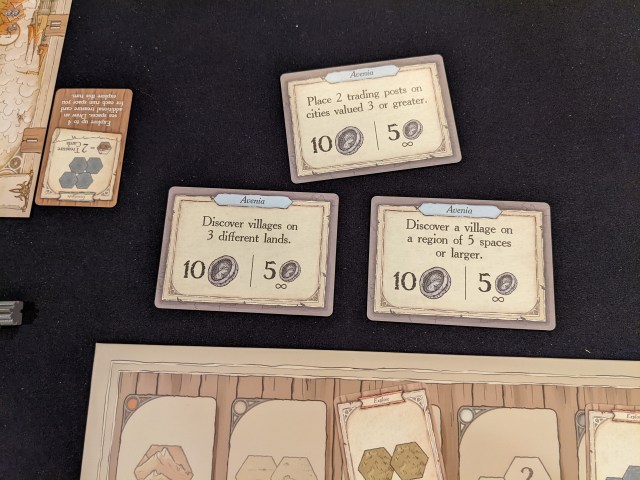
You want to complete areas on your board, cross the seas to new land, and establish new cities on the board. You can explore capsized ships for treasure — which gives you special placement capabilities — and create linked connections between locations to score bonus points. The 3 Goals (chosen at random at the start of the game) can be completed by all players, with those who complete it first scoring more points. Continue this process until all the cards in the exploration deck are revealed.
At the end of a round, all cubes are removed from each board, leaving only the cities behind (As well as any newly placed villages, trading posts, treasure tokens and discovery towers), so if you don’t establish new things, you’ll be stuck in the same places. As you prepare for the new round, add in the Era card for the current era to the deck before shuffling.
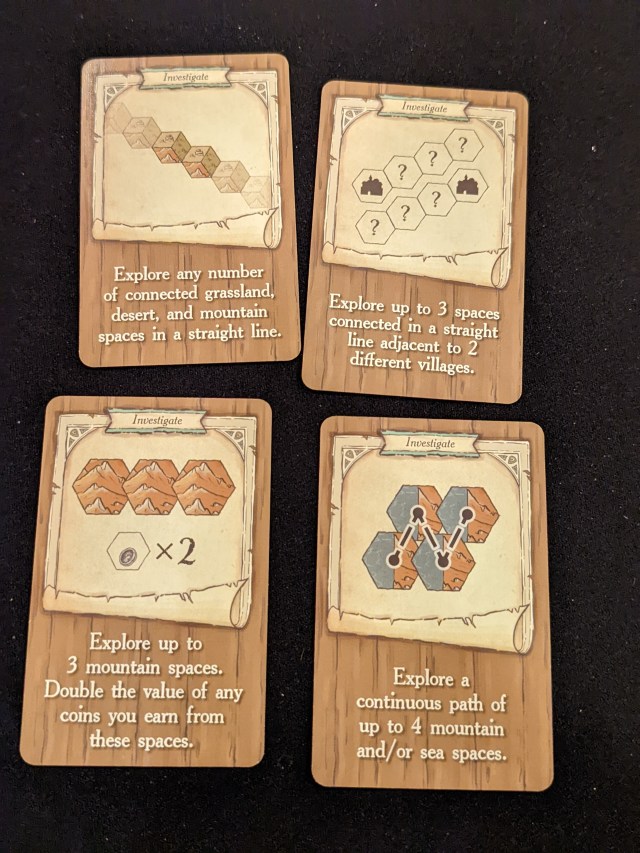
When the Era cards are drawn, all players get to draw two Investigate cards from the deck, and they choose one of them to place next to their board. They then take the explore action seen on that card. For the rest of the game, when that particular Era card comes up, they must use that action card they selected. The unchosen card is placed back at the bottom of the deck – though I’m pretty sure you won’t go thru the deck during the game.
The game continues through the four eras. At the end of the fourth era, the player with the most coins wins. (Note that throughout the game, you have been collecting coin tokens but keeping the amount secret). Ties go to the player with the most discovery towers.
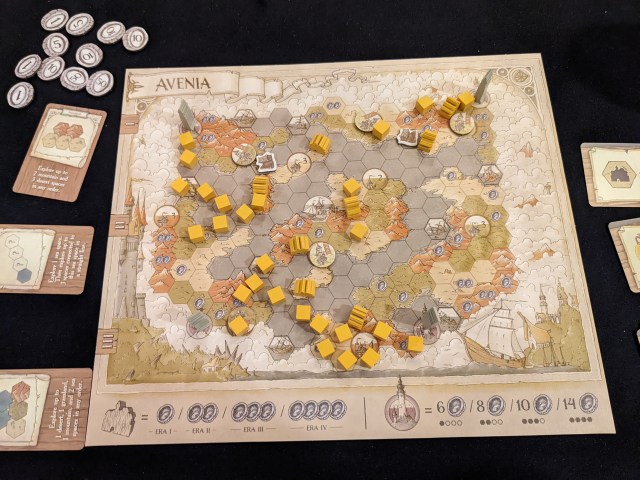
My thoughts on the game
The Guild of Merchant Explorers was a game that I honestly hadn’t heard much about prior to its arrival on my doorstep. But, once I opened the box and read the back cover, I was pretty sure that this was my kind of game. In many ways, it is a more physical form of a roll and write game – in the sense that a card is flipped up, and then each player gets to do things to their identical starting map. Here, the physical components make a bit more sense as there is incomplete erasure of the board between eras, and that could be cumbersome and easily botched with a dry erase marker. Additionally, each game is like a puzzle as you try to plan for your exploration knowing most of the cards that are coming your way – though you are never sure of the order of those cards!
The game definitely gives you a feel of adventuring, and I like the way that your later exploration directly builds upon the things you have previously discovered. Sometimes, you will use villages to keep pushing outwards, though I definitely like to build a village near a high paying coin spot so that I can hit it in each era for a quick payoff. The choice of era cards is also super important as you will use your chosen cards at least once each in every successive round.
One thing I have made sure to do when teaching the game is to make sure that all the players know what the 5 basic action cards are. It’s vital to remember what these cards are as you try to plan your moves in an era. Especially if you’re trying to establish a village; you’ll really want to remember which cards are still to come in the deck. The board serves as a reminder as to which of the basic cards (and era cards) have been drawn in each era.
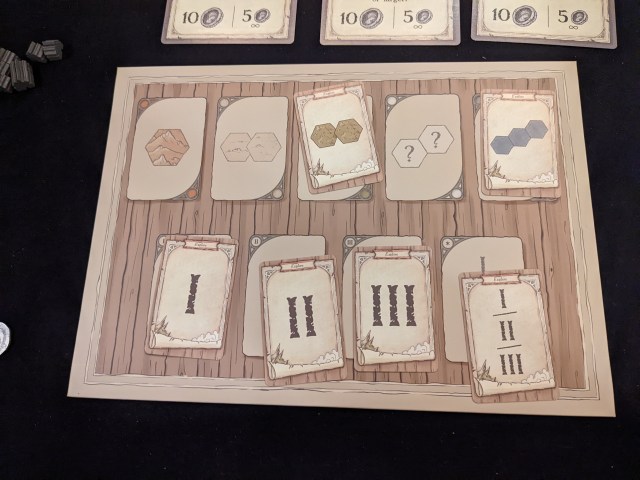
I really like the way that the six different maps that I have (my game came with the mini expansion Queen’s Orders) all feel a little different. Most of the maps come with a special rule or two that help set them apart. Additionally, the goal cards are individualized for each map, and since you only play with 3 of the 6 goal cards in any game, nearly every play will be at least a little different.
Though there are only 6 cards in the first era, 4 of which are exactly the same, 1 wild and 1 unique investigate card – I’ve been quite surprised with how different the player maps look at the start of the second era; especially when the investigate card comes up early in the first era! The maps seem to quickly diverge from each other, and as a result, while the game is mostly simultaneous solitaire – I tend to get the feeling that I’m doing my own thing, not just copying what everyone else is doing. The variation tends to expand with each further era as you keep using your chosen investigation cards which are often quite different from what other people have chosen.
The game does include a solo mode, which has become a de rigeur thing post COVID – where your goal is to reach a certain coin level while also completing the 3 goal cards. Interestingly, The Guild of Merchant Explorers is also designed so that you can play remotely with one or more copies. If there is only one copy, players may have to use proxies for their maps and Investigate cards, but it can all be done over a video chat link.
Dunstan and Gilbert tend to make games that I like, and this one is no exception. It’s quick to play, and the level of puzzle solving here is right where I like it. I’m generally focused on my own map, but the common goals keep me racing a bit for those bonus points. The variety of maps has kept the game fresh so far, and I suspect that I will be playing this one for a while, both multiplayer as well as possibly solo.
Thoughts from other Opinionated Gamers
Mark Jackson (13 plays): A really smart adaption of the flip-n-write genre that offers interesting choices and rewards planning. The solo system is well-designed and doesn’t require any additional administration besides set-up. (I like the expansion as well… a couple of more maps, one with an extended map section.)
Dan B. (2 plays): A bit different from the usual flip-and-write fodder and definitely interesting. It did feel hard to reach many areas of the map, but probably experience will help in planning for that. I would definitely play more. I will say that I find the graphics hard to read.
Maricel E. I don’t have this game logged on SPLU but I could’ve sworn I’ve played it and liked it. I do recall that I was initially frustrated and discouraged by the shifting of the eras and seeing all my forward progress reset, but I enjoyed plotting my course and the decisions each turn were crunchy and satisfying, so eventually I learned to maximize my eras and end with the feeling of truly having explored the land.
Ratings from the Opinionated Gamers
- I love it! Dale Y, Mark Jackson, Maricel E.
- I like it. John P, Dan B.
- Neutral. James Nathan
- Not for me…
